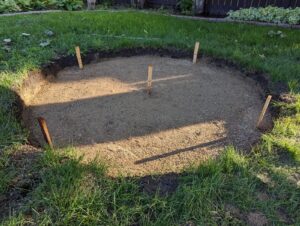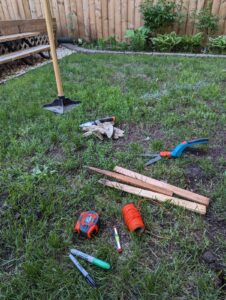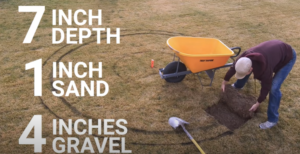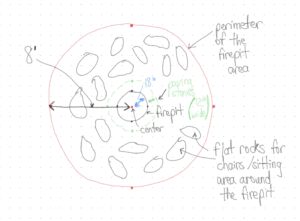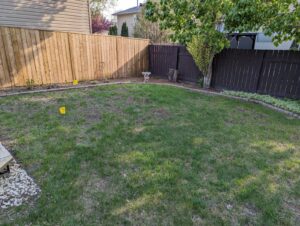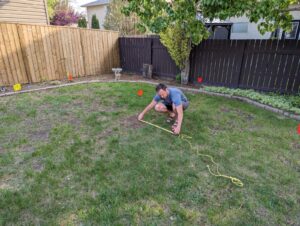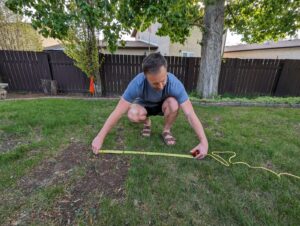On Friday, the paving stones finally arrived!!! (*shrieks like a small child*)
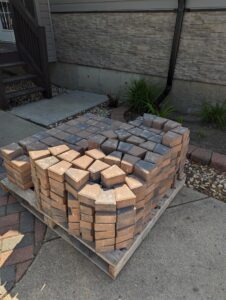
Pallet of paving stones
It was so exciting to start working on this part of the project because, up until now, it’s been a lot of grunt work and physical labour. My body still hurts today, but knowing that the end-product was in sight helped me to fight through the body aches and sore muscles.
Saturday was spent outside the whole afternoon completing these last stages of the project. The first step was leveling 1” of sand throughout the circular area using PVC pipe and a flat object, such as a 2×4”. The PVC pipe helped to ensure a consistent 1” depth of sand throughout and the 2×4” was extremely helpful at leveling the sand once it was added. Here are the steps that I did to complete this project, and some tips I learned along the way thanks to the Bro Builds Patio Firepit video.
Tip #1: make sure your conduit or PVC pipe has an outside diameter of 1”. Most pipes’ dimensions are measured using the inside dimensions, which can actually make a significant difference. Thankfully I had learned this from Bro Builds before I bought my own PVC pipe, so I brought my measuring tape with me to Rona when buying mine.
The process of leveling the 1” of sand is actually quite tedious and time-consuming. Making sure the sand has no bumps or ridges is crucial before laying down the paving stones. You don’t want your paving stones to end up being wavier than SK roads after the winter thaw!
Tip #2: don’t tamp down or put added pressure on the sand before laying the pavers down. (I have a video that will be in my final blog post of me almost crying after my dog decided to walk across the sand when I wasn’t looking). You don’t want the sand compacted because once you put the pavers down, you want them to have room to set into the sand beneath it. This will help to keep your pavers in place, as well.
Tip #3: when it’s time to put the pavers in place, make sure you set the pavers down right where you want them. Try not to slide them around after putting them down or it will make ridges in the sand and cause the pavers to become unlevel over time.
Tip #4: plan out your paving stone placement before starting. My pavers had a variety of light, dark and mixed colours, so distributing them throughout the design will help make the finished product look great. This is where I got my husband’s assistance, which leads into another tip…
Tip #5: having someone to help hand you paving stones or arrange them around the circle saves a lot of time, including a lot of bending over (my back is sore enough today, so shout out to my husband for his assistance with this part!)
Once the pavers were in place, it was time to ensure they stayed there. This involved putting down some extra sand and sweeping it into the cracks.
Tip #6: to help the sand settle into the cracks, use a hand tamper and gently pound down the pavers. This helped the sand to fall into the cracks, and also sets the pavers into place that much better. Using a broom, I continued to push sand into the cracks and also added some extra sand around the outer ring to hold the pavers in place.
Tip #7: for next time, I would have measured and dug a hole that has a diameter that is a few inches wider. This would’ve allowed me to put edge restraints around the perimeter of the stones to help to keep the paver stones in place. I’m slightly concerned that the outside ring of pavers might start moving over time. At the same time, I think this would provide a sharp final look to the paving stone area.
All in all, I’m really happy with the finished product, and I’m proud myself. This project was a lot to take on and it was both mentally and physically exhausting. These last few steps that I did on Saturday took me about 5 hours to complete. I recorded this whole process (excluding the last few minutes because my phone died), so a video of me completing these steps is in the works. I’m just waiting for it to upload and then I will include this in my final blog post. In the meantime, here are some before, during, and after pictures of the entire process. Thanks so much for reading, learning with me, and following along!
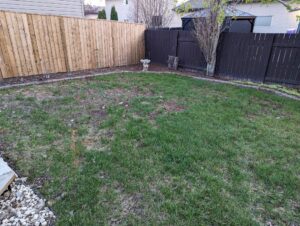
Area of my backyard before the project began.
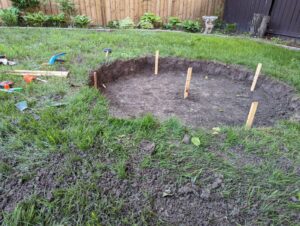
Hole before starting to lay the base layer of gravel.

Base layer of gravel is now complete.
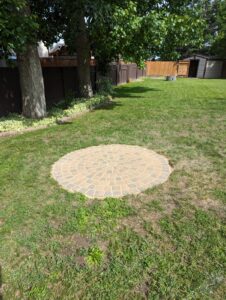
Finished product with paving stones in place.
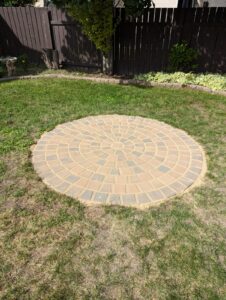
Finished product with paving stones in place.








